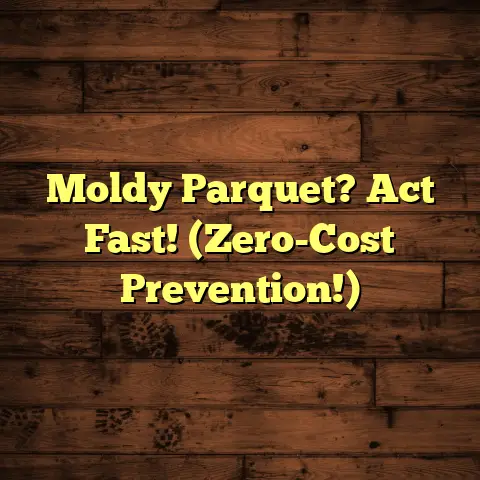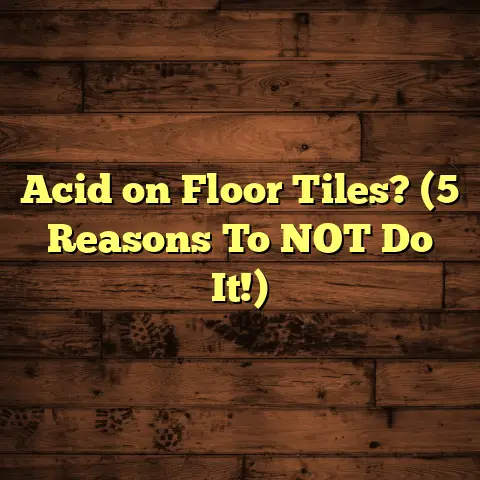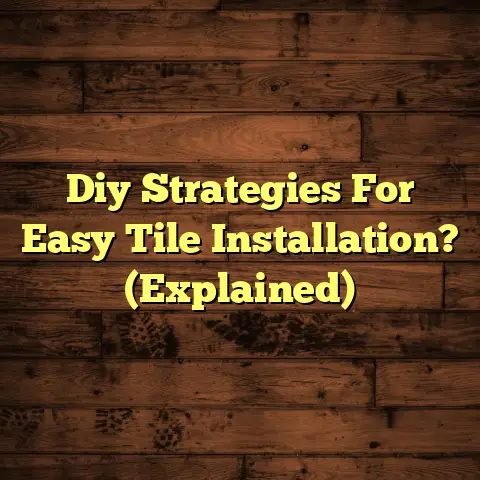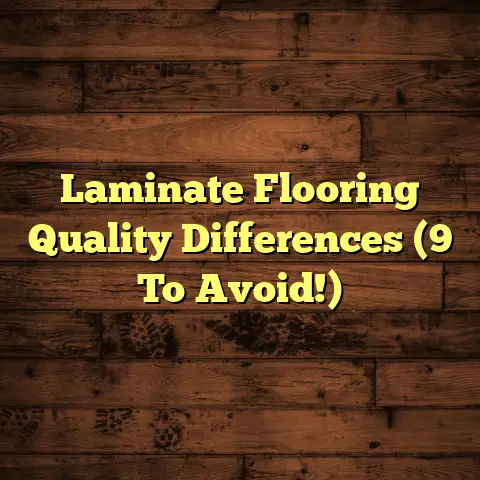Remove Glued Hardwood? (1-Day Demo Guide!)
Maybe you’re prepping for a big family get-together, or maybe you’re just itching for a change. Whatever the reason, the thought of ripping up that glued-down hardwood can be seriously daunting. Believe me, I get it.
But what if I told you that you could tackle this project in just one day? Yep, you heard right! I’m going to walk you through the entire process, step-by-step, so you can confidently transform your space. Let’s get started!
Understanding the Challenge
So, what exactly is glued hardwood flooring? Essentially, it’s solid or engineered hardwood that’s directly adhered to the subfloor using a strong adhesive. This method was popular for a while because it offered a stable, squeak-free installation.
Why remove it, though? Well, there are plenty of reasons. Maybe the floor is warped, discolored, or damaged. Perhaps you’re updating your home’s style, or you need to address hidden moisture issues beneath the planks.
And let’s be honest, sometimes you just don’t like it anymore!
The type of adhesive used plays a huge role in how difficult the removal process will be. Some common types include:
- Urethane adhesives: These are incredibly strong and durable, but they can be a pain to remove.
- Acrylic adhesives: Generally, these are easier to work with than urethane-based options.
- Epoxy adhesives: Often used in commercial settings, these are super tough and require specialized tools for removal.
Common Signs You Need New Flooring:
| Sign | Description |
|---|---|
| Warping | Planks are visibly uneven or buckled, often due to moisture. |
| Discoloration | Fading, staining, or inconsistent coloring that detracts from the floor’s appearance. |
| Damage | Scratches, dents, gouges, or cracks that compromise the floor’s integrity and aesthetics. |
| Loose Planks | Individual boards that are no longer securely attached to the subfloor, creating movement and potential tripping hazards. |
| Moisture Issues | Signs of water damage, such as mold, mildew, or a musty odor, indicating underlying problems that need to be addressed. |
| Outdated Style | The flooring no longer complements the overall design of the home, prompting a desire for a more modern or updated look. |
| Resale Value | Replacing old or damaged flooring can significantly increase the value and appeal of a home when preparing it for sale. |
Preparation for the Demo Day
Alright, let’s get down to brass tacks. Before you start swinging that pry bar, you need to gather your tools and prep the room. Trust me, proper preparation will save you a ton of time and frustration.
Tools and Materials You’ll Need:
- Safety Gear: Gloves, safety glasses, knee pads, and a dust mask are non-negotiable. Protect yourself!
- Pry Bar: A sturdy pry bar is essential for lifting the planks. I recommend a flat pry bar for better leverage.
- Utility Knife: For scoring around edges and cutting through stubborn adhesive.
- Heat Gun: This is your best friend for softening that stubborn adhesive.
- Flooring Scraper: A long-handled scraper will help you remove adhesive residue from the subfloor.
- Hammer: To tap the pry bar or scraper.
- Chisel: For getting under edges.
- Solvent (Optional): Mineral spirits or a specialized adhesive remover can help dissolve stubborn residue.
- Trash Bags/Containers: For easy cleanup.
- Shop Vac: For clearing dust and debris.
Preparing the Room:
- Clear the Furniture: Move everything out of the room. Trust me, you’ll need the space.
- Cover Vents: Protect your HVAC system by covering any vents with plastic sheeting and tape.
- Assess the Subfloor: Take a good look at the subfloor. Note any cracks, unevenness, or signs of moisture. You’ll need to address these issues before installing new flooring.
- Ventilation: Open windows and doors to ensure good ventilation. This is especially important when using a heat gun or solvents.
Safety First!
- Always wear safety glasses to protect your eyes from flying debris.
- Use gloves to protect your hands from adhesives and sharp edges.
- Knee pads will save your knees from a world of pain.
- Work in a well-ventilated area to avoid inhaling fumes.
The One-Day Demo Process
Okay, it’s go-time! Let’s break down the removal process into manageable steps. Remember to take your time and be patient. This isn’t a race!
Step 1: Assessing the Flooring
Before you start tearing things up, take a moment to assess the situation. Try to determine what type of adhesive was used. This will help you choose the best removal strategy.
- Test a Small Area: Use a heat gun on a small, inconspicuous area of the floor. If the adhesive softens easily, you’re in luck! If it’s rock-solid, you’ll need a more aggressive approach.
- Look for Clues: Check for any markings on the flooring or subfloor that might indicate the type of adhesive used.
- Consult the Experts: If you’re unsure, contact a flooring professional or adhesive manufacturer for advice.
Step 2: Heating the Adhesive
This is where the heat gun comes in. The goal is to soften the adhesive enough to make it easier to pry up the planks.
- Set the Heat Gun: Start with a low setting and gradually increase the heat as needed. Be careful not to overheat the wood, as this can damage it.
- Apply Heat Evenly: Hold the heat gun a few inches above the floor and move it back and forth in a sweeping motion. Focus on a small area at a time.
- Test the Area: After heating for a minute or two, try to pry up a plank. If it comes up easily, you’re good to go. If not, apply more heat.
Step 3: Removing the Planks
Now for the fun part! Grab your pry bar and let’s get to work.
- Start at the Edges: Begin by prying up the planks along the perimeter of the room. These are usually the easiest to remove.
- Use a Chisel: If the edges are stubborn, use a chisel to create a gap between the plank and the subfloor.
- Pry Carefully: Insert the pry bar into the gap and gently lift the plank. Avoid using excessive force, as this can damage the subfloor.
- Work Your Way Inward: Once you’ve removed the perimeter planks, start working your way towards the center of the room.
- Alternate Sides: If a plank is particularly difficult to remove, try prying from different sides to loosen it.
Step 4: Cleaning Up
Once you’ve removed all the planks, you’ll be left with adhesive residue on the subfloor. This needs to be removed before you can install new flooring.
- Scrape the Adhesive: Use a long-handled flooring scraper to remove as much of the adhesive as possible. Apply firm, even pressure and work in overlapping strokes.
- Use a Solvent (If Needed): If scraping alone isn’t enough, try using a solvent like mineral spirits or a specialized adhesive remover. Follow the manufacturer’s instructions carefully and always wear gloves and eye protection.
- Ventilate the Area: Solvents can produce harmful fumes, so make sure the room is well-ventilated.
- Clean the Subfloor: Once you’ve removed the adhesive, vacuum the subfloor thoroughly to remove any remaining debris.
Final Touches
Congratulations! You’ve successfully removed your glued hardwood flooring. But the job isn’t quite done yet. Here are a few final steps to ensure a smooth transition to your new flooring.
Disposing of the Old Flooring:
- Check Local Regulations: Contact your local waste management authority to find out the proper disposal methods for old flooring and adhesive.
- Recycle (If Possible): Some recycling centers accept wood flooring. Check to see if this is an option in your area.
- Dispose of Properly: If recycling isn’t an option, dispose of the flooring and adhesive in accordance with local regulations.
Assessing the Subfloor Condition:
- Check for Moisture: Use a moisture meter to check the moisture content of the subfloor. It should be within the acceptable range for your new flooring.
- Leveling: Use a long level to check for any unevenness in the subfloor. If necessary, use a self-leveling compound to create a smooth, even surface.
- Cleanliness: Make sure the subfloor is clean, dry, and free of any debris before installing your new flooring.
Empowering Transformation
Take a moment to look around. You did it! You’ve successfully removed that old, glued-down hardwood flooring and created a blank canvas for your new space.
I know it can seem like a daunting task at first, but with the right tools, preparation, and a little elbow grease, you can absolutely transform your home.
So go ahead, embrace your DIY spirit and create the space you’ve always dreamed of! And remember, I’m here to help if you have any questions along the way. Happy flooring!





